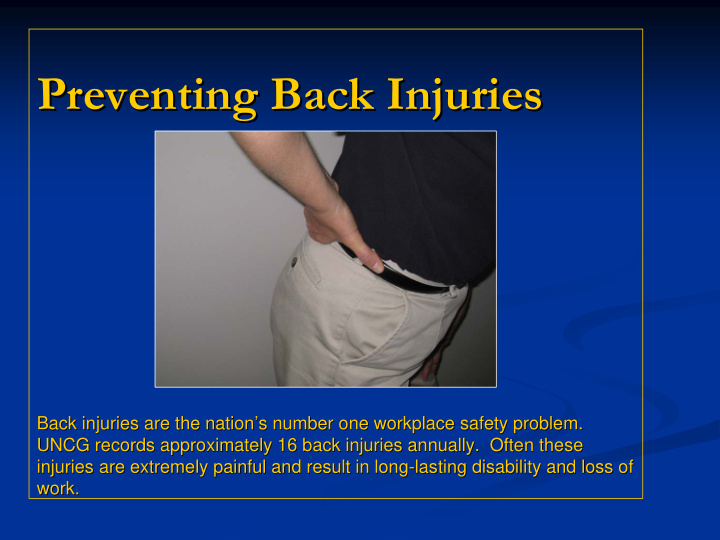



Preventing Back Injuries Preventing Back Injuries Back injuries are the nation’ ’s number one workplace safety problem. s number one workplace safety problem. Back injuries are the nation UNCG records approximately 16 back injuries annually. Often these se UNCG records approximately 16 back injuries annually. Often the injuries are extremely painful and result in long- injuries are extremely painful and result in long -lasting disability and loss of lasting disability and loss of work. work.
What You Can Do What You Can Do A number of solutions can be used to A number of solutions can be used to reduce the risk of back injuries. This reduce the risk of back injuries. This training module will review a number of training module will review a number of these solutions that have been shown to these solutions that have been shown to reduce back strain and injuries. reduce back strain and injuries. No doubt you have heard about proper No doubt you have heard about proper lifting techniques, however this module lifting techniques, however this module would like to go into them in detail and will would like to go into them in detail and will offer you specific suggestions when lifting offer you specific suggestions when lifting common workplace items. First let’ common workplace items. First let ’s look s look at the steps when lifting an object. at the steps when lifting an object.
Prepare for the Lift Prepare for the Lift Check the entire path you plan to Check the entire path you plan to 1) 1) take when lifting the item. take when lifting the item. Make sure you are wearing shoes Make sure you are wearing shoes 2) 2) that give you good balance, even that give you good balance, even support across the sole and most support across the sole and most of all traction. of all traction.
Know What You’ ’re About to Pick re About to Pick- -up up Know What You Know the weight of the object by Know the weight of the object by 3) 3) reading the label or cautiously reading the label or cautiously hefting to check the weight and hefting to check the weight and center of gravity and best place to center of gravity and best place to grab the item. grab the item.
Lift the Object Lift the Object Face the object directly and get your Face the object directly and get your 4) 4) body as close as you can to the item body as close as you can to the item you plan to lift. you plan to lift. Place your feet apart slightly. Place your feet apart slightly. 5) 5) Squat down, bending your knees. Squat down, bending your knees. 6) 6) Place one knee and foot slightly Place one knee and foot slightly behind you if it will give you more behind you if it will give you more power. power. Grip the object firmly. Grip the object firmly. 7) 7) Straighten your back and tighten Straighten your back and tighten 8) 8) your stomach muscles. your stomach muscles.
Lift With Your Legs, NOT Your Back Lift With Your Legs, NOT Your Back Use your legs to move to a Use your legs to move to a 9) 9) standing position. Keeping your standing position. Keeping your back straight as you move to a back straight as you move to a standing position. standing position. 10) Use your large thigh muscles to lift Use your large thigh muscles to lift 10) the load, instead of bending your the load, instead of bending your back and placing stress on the back and placing stress on the lower back muscles, which tend to lower back muscles, which tend to be weaker. be weaker.
Carry the Load Carry the Load 11) Continue to grip the load firmly Continue to grip the load firmly 11) and hold it as close as you can to and hold it as close as you can to your body. your body. 12) Keep your back straight. Keep your back straight. 12) 13) Keep your stomach muscles tight. Keep your stomach muscles tight. 13)
Setting Down the Load Setting Down the Load 14) Face the place you where you will be Face the place you where you will be 14) lowering the load straight ahead. lowering the load straight ahead. 15) Keep the back straight and stomach tight. Keep the back straight and stomach tight. 15) 16) Spread the feet wider apart. Spread the feet wider apart. 16) 17) Slowly bend your knees until you are in a Slowly bend your knees until you are in a 17) squat position. squat position. 18) Remember to keep the load close to the body. Remember to keep the load close to the body. 18) 19) Lower the object to the floor or shelf. Lower the object to the floor or shelf. 19)
Alternatives to Lifting Alternatives to Lifting Ask a co- Ask a co -worker to help move the worker to help move the Use a hand-cart or pushcart to move object. the load. object.
Do NOT… … Do NOT DO NOT TWIST when DO NOT TWIST when � picking up, picking up, � � walking, or walking, or � � depositing the load. depositing the load. � The twisting motion puts high The twisting motion puts high pressure on the weakest muscles in pressure on the weakest muscles in the back and is most often the cause the back and is most often the cause of back injuries while lifting. of back injuries while lifting.
Additional Ways Additional Ways To Prevent Back Injuries To Prevent Back Injuries Maintain good posture, when � standing and sitting. Keep within your recommended � weight range. Exercise regularly. Walking, � bicycling and swimming are all great activities that can strengthen lower back muscles and soft stomach muscles.
Recommend
More recommend